自制单片机之五(2)……LCD1602的驱动
我们接着上次的系统板制做:
本文引用地址:https://www.eepw.com.cn/article/201611/316083.htm
新买的1602LCD,20元,贵不?
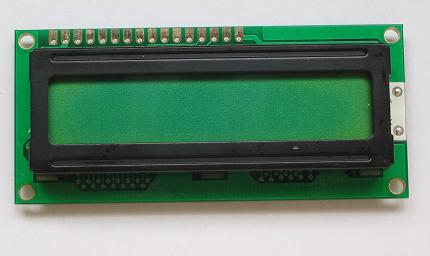
反面:
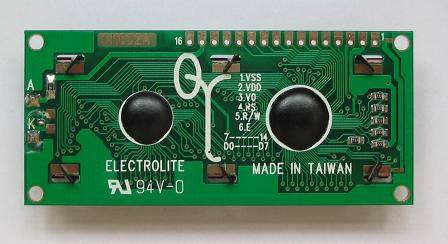
组装后: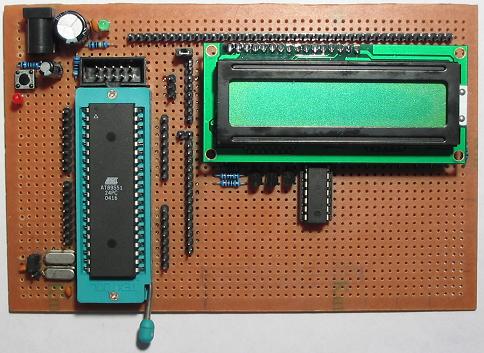
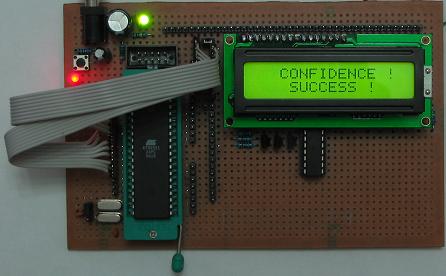

具体电路图: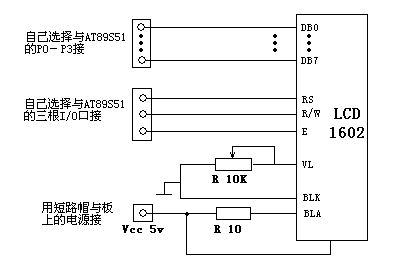

接口说明: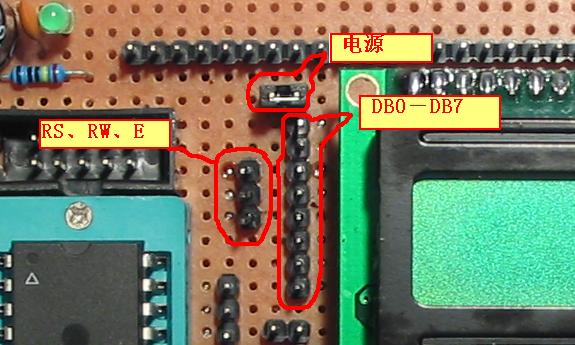

运行:

用户自定义字符的应用:
我们从CGROM表上可以看到,在表的最左边是一列可以允许用户自定义的CGRAM,从上往下看着是16个,实际只有8个字节可用。它的字符码是00000000-00000111这8个地址,表的下面还有8个字节,但因为这个CGRAM的字符码规定0-2位为地址,3位无效,4-7全为零。因此CGRAM的字符码只有最后三位能用也就是8个字节了。等效为0000X111,X为无效位,最后三位为000-111共8个。
如果我们要想显示这8个用户自定义的字符,操作方法和显示CGROM的一样,先设置DDRAM位置,再向DDRAM写入字符码,例如“A”就是41H。现在我们要显示CGRAM的第一个自定义字符,就向DDRAM写入00000000B(00H),如果要显示第8个就写入00000111(08H),简单吧!
好!现在我们来看怎么向这八个自定义字符写入字模。有个设置CGRAM地址的指令大家还记得吗?赶快再找出来看看。
如果我们要想显示这8个用户自定义的字符,操作方法和显示CGROM的一样,先设置DDRAM位置,再向DDRAM写入字符码,例如“A”就是41H。现在我们要显示CGRAM的第一个自定义字符,就向DDRAM写入00000000B(00H),如果要显示第8个就写入00000111(08H),简单吧!
好!现在我们来看怎么向这八个自定义字符写入字模。有个设置CGRAM地址的指令大家还记得吗?赶快再找出来看看。

从这个指令可以看出指令数据的高2位已固定是01,只有后面的6位是地址数据,而这6位中的高3位就表示这八个自定义字符,最后的3位就是字模数据的八个地址了。例如第一个自定义字符的字模地址为01000000-01000111八个地址。我们向这8个字节写入字模数据,让它能显示出“℃”
地址:01000000 数据:00010000 图示:○○○■○○○○
01000001 00000110 ○○○○○■■○
01000010 00001001 ○○○○■○○■
01000011 00001000 ○○○○■○○○
01000100 00001000 ○○○○■○○○
01000101 00001001 ○○○○■○○■
01000110 00000110 ○○○○○■■○
01000111 00000000 ○○○○○○○○
下面我们写一段程序让这8个自定义字符显示出一个心的图案:
# include
unsigned char table1[]={0x03,0x07,0x0f,0x1f,0x1f,0x1f,0x1f,0x1f,
0x18,0x1E,0x1f,0x1f,0x1f,0x1f,0x1f,0x1f,
0x07,0x1f,0x1f,0x1f,0x1f,0x1f,0x1f,0x1f,
0x10,0x18,0x1c,0x1E,0x1E,0x1E,0x1E,0x1E,
0x0f,0x07,0x03,0x01,0x00,0x00,0x00,0x00,
0x1f,0x1f,0x1f,0x1f,0x1f,0x0f,0x07,0x01,
0x1f,0x1f,0x1f,0x1f,0x1f,0x1c,0x18,0x00,
0x1c,0x18,0x10,0x00,0x00,0x00,0x00,0x00};//心图案
unsigned char table[]={0x10,0x06,0x09,0x08,0x08,0x09,0x06,0x00};//字符℃
#define CLEARSCREEN LCD_write_command(0x01)
/**************定义接口************************/
#define LCDIO P2
sbit LCD1602_RS=P3^0;
sbit LCD1602_RW=P3^1;
sbit LCD1602_EN=P3^2;
sbit LCD1602_RS=P3^0;
sbit LCD1602_RW=P3^1;
sbit LCD1602_EN=P3^2;
/**************定义函数************************/
void LCD_write_command(unsigned char command);//写入指令函数
void LCD_write_dat(unsigned char dat);//写入数据函数
void LCD_set_xy( unsigned char x, unsigned char y );//设置显示位置函数
void LCD_dsp_char( unsigned x,unsigned char y,unsigned char dat);//显示一个字符函数
void LCD_dsp_string(unsigned char X,unsigned char Y,unsigned char *s);//显示字符串函数
void LCD_init(void);//初始化函数
void delay_nms(unsigned int n);//延时函数
/********************************************/
void LCD_write_command(unsigned char command);//写入指令函数
void LCD_write_dat(unsigned char dat);//写入数据函数
void LCD_set_xy( unsigned char x, unsigned char y );//设置显示位置函数
void LCD_dsp_char( unsigned x,unsigned char y,unsigned char dat);//显示一个字符函数
void LCD_dsp_string(unsigned char X,unsigned char Y,unsigned char *s);//显示字符串函数
void LCD_init(void);//初始化函数
void delay_nms(unsigned int n);//延时函数
/********************************************/
/************初始化函数****************/
void LCD_init(void)
{
CLEARSCREEN;//clear screen
LCD_write_command(0x38);//set 8 bit da
LCD_write_command(0x0c);//open display (enable lcd display)
LCD_write_command(0x80);//set lcd first display address
CLEARSCREEN;//clear screen
}
/****************************************************/
void LCD_init(void)
{
CLEARSCREEN;//clear screen
LCD_write_command(0x38);//set 8 bit da
LCD_write_command(0x0c);//open display (enable lcd display)
LCD_write_command(0x80);//set lcd first display address
CLEARSCREEN;//clear screen
}
/****************************************************/
/**************写指令函数********************************/
void LCD_write_command(unsigned char command)
{
LCDIO=command;
LCD1602_RS=0;
LCD1602_RW=0;
LCD1602_EN=0;
LCD1602_EN=1;
delay_nms(10);
}
/***************************************************/
/****************写数据函数************************/
void LCD_write_dat(unsigned char dat)
{
LCDIO=dat;
LCD1602_RS=1;
LCD1602_RW=0;
LCD1602_EN=0;
delay_nms(1);
LCD1602_EN=1;
}
/****************************************************/
void LCD_write_command(unsigned char command)
{
LCDIO=command;
LCD1602_RS=0;
LCD1602_RW=0;
LCD1602_EN=0;
LCD1602_EN=1;
delay_nms(10);
}
/***************************************************/
/****************写数据函数************************/
void LCD_write_dat(unsigned char dat)
{
LCDIO=dat;
LCD1602_RS=1;
LCD1602_RW=0;
LCD1602_EN=0;
delay_nms(1);
LCD1602_EN=1;
}
/****************************************************/
/***************设置显示位置**************************/
void LCD_set_xy( unsigned char x, unsigned char y )
{
unsigned char address;
if (y == 1)
address = 0x80 + x;
else
address =0xc0+ x;
LCD_write_command(address);
}
/***************************************************/
void LCD_set_xy( unsigned char x, unsigned char y )
{
unsigned char address;
if (y == 1)
address = 0x80 + x;
else
address =0xc0+ x;
LCD_write_command(address);
}
/***************************************************/
/****************显示一个字符**********************/
void LCD_dsp_char( unsigned x,unsigned char y,unsigned char dat)
{
LCD_set_xy( x, y );
LCD_write_dat(dat);
}
/**********************************************/
void LCD_dsp_char( unsigned x,unsigned char y,unsigned char dat)
{
LCD_set_xy( x, y );
LCD_write_dat(dat);
}
/**********************************************/
/***************显示字符串函数***************/
void LCD_dsp_string(unsigned char X,unsigned char Y,unsigned char *s)
{
LCD_set_xy( X, Y );
while (*s)
{
LCD_write_dat(*s);
s ++;
}
}
/***********************************************/
void LCD_dsp_string(unsigned char X,unsigned char Y,unsigned char *s)
{
LCD_set_xy( X, Y );
while (*s)
{
LCD_write_dat(*s);
s ++;
}
}
/***********************************************/
/********** 延时**********************/
void delay_nms(unsigned int n)
{
unsigned int i=0,j=0;
for (i=n;i>0;i--)
for (j=0;j<10;j++);
}
/**************************************/
void delay_nms(unsigned int n)
{
unsigned int i=0,j=0;
for (i=n;i>0;i--)
for (j=0;j<10;j++);
}
/**************************************/
/***********主函数**************/
void main(void)
{
unsigned char i,j,k,tmp;
LCD_init();
delay_nms(100);
tmp=0x40;//设置CGRAM地址的格式字
k=0;
for(j=0;j<8;j++)
{
for(i=0;i<8;i++)
{
LCD_write_command(tmp+i); // 设置自定义字符的 CGRAM 地址
delay_nms(2);
LCD_write_dat(table1[k]); // 向CGRAM写入自定义字符表的数据
k++;
delay_nms(2);
}
tmp=tmp+8;
}
LCD_dsp_string(1,1,"LCD TEST ");//在第一行第一列显示“LCD TEST”
LCD_dsp_string(1,2,"SUCCESSFUL ");//在第二行第一列显示“SUCCESSFUL”
for (i=0;i<4;i++)
{
LCD_dsp_char( 12+i,1,i);//在第一行第12列位置显示心图案的上半部
delay_nms(1);
}
for (i=4;i<8;i++)
{
LCD_dsp_char( 12+i-4,2,i);在第二行第12列位置显示心图案的下半部
delay_nms(1);
}
while (1);
}
/********************************************************************/
void main(void)
{
unsigned char i,j,k,tmp;
LCD_init();
delay_nms(100);
tmp=0x40;//设置CGRAM地址的格式字
k=0;
for(j=0;j<8;j++)
{
for(i=0;i<8;i++)
{
LCD_write_command(tmp+i); // 设置自定义字符的 CGRAM 地址
delay_nms(2);
LCD_write_dat(table1[k]); // 向CGRAM写入自定义字符表的数据
k++;
delay_nms(2);
}
tmp=tmp+8;
}
LCD_dsp_string(1,1,"LCD TEST ");//在第一行第一列显示“LCD TEST”
LCD_dsp_string(1,2,"SUCCESSFUL ");//在第二行第一列显示“SUCCESSFUL”
for (i=0;i<4;i++)
{
LCD_dsp_char( 12+i,1,i);//在第一行第12列位置显示心图案的上半部
delay_nms(1);
}
for (i=4;i<8;i++)
{
LCD_dsp_char( 12+i-4,2,i);在第二行第12列位置显示心图案的下半部
delay_nms(1);
}
while (1);
}
/********************************************************************/
实际效果如图:
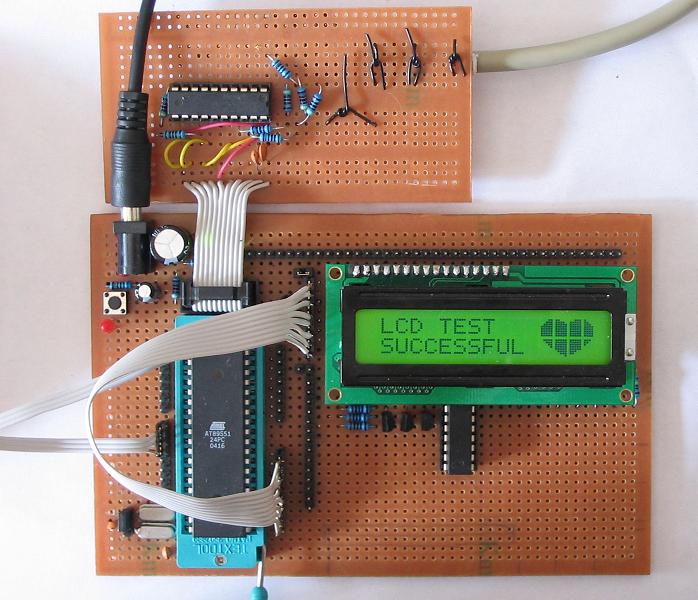



评论